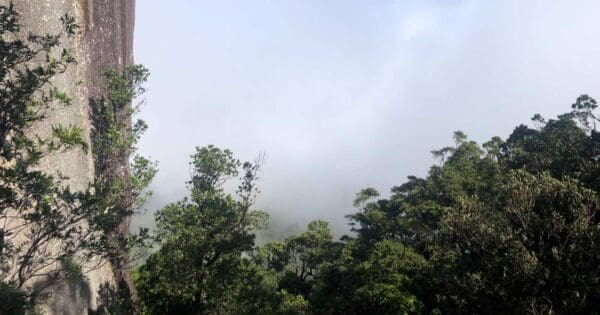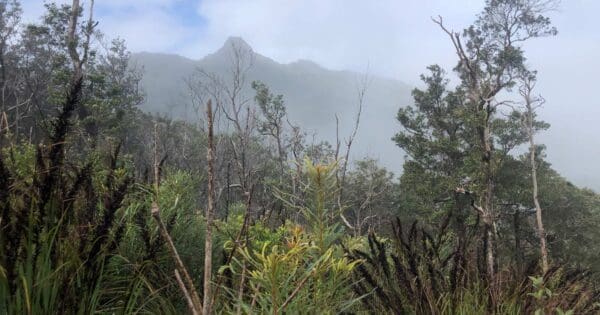Hike at a Glance
Max elevation: 0m
Min elevation: 0m
Total Ascent: 0m
Hike overview
The Mount Sorrow Ridge Trail is located within the Daintree National Park, Cape Tribulation section. This trail climbs from the coastal lowlands of Cape Tribulation, up the rainforest-clad ridge of Mount Sorrow to a lookout offering views of the beautiful Daintree coastline, Snapper Island and beyond.
Mossman Gorge section
The Great Dividing Range is close to the coast in this region. This section covers 56,500 ha of mostly inaccessible rainforests and mountain woodlands. The popular Mossman Gorge is in the southern part of the park.
Cape Tribulation section
Cape Tribulation also lies in the park. Originally the cape belonged to Cape Tribulation National Park from 1981 but was amalgamated into Daintree National Park in 1983. This section covers 17,000 ha including the coastal range (Thornton's Peak, Mount Hemmant, and Mount Sorrow, going north from the Daintree river) and contains Australia's last extensive stands of lowland rainforest. It has extensive (and relatively) unspoiled beaches from Thornton beach to Cape Tribulation beach - fringed with the increasingly rare littoral (beachside) rainforest. The Daintree river is the southern boundary for the region - reinforced by the need to take a cable ferry across the Daintree river. Much of the coastal flatlands, especially to the south of the Alexandra range, and in Cow Bay, were cleared for agriculture in the late 1800s with a major clearing push in the 1970s. A lot of this has since recovered or has been settled.
The Daintree National Park's traditional owners are the Eastern Kuku Yalanji Aboriginal people. Many of the natural features of the landscape hold spiritual significance for the traditional owners. One of these features is the location of the bouncing stones at Thornton Beach. The rocks here are hornfels, metamorphic rocks resulting from the effects of a major intrusion of granite that produced the coastal mountains. They are very elastic, when bounced on the local rock pavement; The park contains the Mossman River to the south, the Daintree River and the Bloomfield River to the north.
For more information on this hiking trail, please visit Queensland.com
Track grade
Grade 5 (Difficult) - Walks for the Most Experienced: Grade 5 represents the most challenging walking tracks on the AWTGS. These are only recommended for very experienced and fit walkers with specialised skills, including navigation and emergency first aid. Tracks are likely to be very rough, very steep, and unmarked. Walks may be more than 20 kilometers. These challenging walks demand a high level of fitness and experience to navigate difficult terrain, significant elevation changes, and potentially unformed paths.
Walk map and GPX file
Do you have a GPX file for this hike? Feel free to email it to me so I can add it to this hikes info.
Click to add your file >>
Content use
Please don’t copy GPX files or content from this site to AllTrails or other platforms. Each trail has been personally mapped, documented, and refined to support Australia’s bushwalking and hiking community. While some details come from land managers, every listing reflects significant personal effort. This is a free, community-driven initiative—your respect helps keep it that way.
Gallery
Got any photos from this hike? Your photos can help others plan. Share shots from along the trail so fellow hikers know what to expect.
Click to add your photos >>
Getting there
Getting to the trailhead: Daintree National Park.
Need a rental car to get you to the hike? Find one here.
About the region
The Daintree rainforest is a national park in Far North Queensland, Australia, 1,502 km (933 mi) northwest of Brisbane and 100 km (62 mi) northwest of Cairns. It was founded in 1981[1] and is part of the Wet Tropics of Queensland. In 1988 it became a World Heritage Site. The park consists of two sections, with a settled agricultural area between them which includes the towns of Mossman and Daintree Village.
One entrance to Daintree National Park is located south of the Daintree River at Mossman Gorge where a visitor centre has been built from where tourists take a shuttle bus to the gorge, where they can take a walk or a refreshing swim..
The most spectacular and oldest part of the Daintree rain forest is north of the Daintree River. After crossing the river on an old fashioned cable ferry there is a range of boardwalks and untouched beaches to explore, and the endangered cassowary can be encountered anywhere.
Daintree National Park is valued because of its exceptional biodiversity. It contains significant habitat for rare species and prolific birdlife. The name is derived from the Daintree River, which was named by George Elphinstone Dalrymple, an early explorer of the area, after his friend Richard Daintree.
Find a place to stay
Wondering where to stay near this hike? Find accommodation close to the trailhead — hotels, cabins and campgrounds nearby. Click the button to view the interactive map.
Closest towns to this walk: Cape Tribulation, Cow Bay, Daintree Village, Mossman, Port Douglas
Let someone know
Heading out? Fill in a trip intentions form so someone knows your plans. If things go wrong, they can raise the alarm fast, giving you peace of mind on the trail.
Similar walks nearby
Looking for more walks in or near Daintree National Park? Try these trails with a similar difficulty grade.
Suggest an edit
Notice something different about this trail? Whether it’s a new feature, a route change, or a closure, share your update so we can keep our info accurate and helpful for fellow hikers.
Click to suggest edits >>
Explore safe
Plan ahead and hike safely! Carry enough water, pack layers for changing conditions, and bring safety gear like a torch, PLB, and reliable communication device. Check official sources for trail updates, closures, and access requirements, and review local weather and bushfire advice. Most importantly, share your plans with someone before you go. Being prepared makes for a safer and more enjoyable hike! Stay Safe, Explore More, and Always #ExploreSafe.
Packing checklists
What you carry in your pack depends on factors like weather, terrain, and your adventure type. Not sure what to bring? My free planning, food, and packing checklists are a great starting point, covering day hikes, overnight trips, and multi-day adventures. Use them to customise your kit and always prioritise safety.
Acknowledgement of Country
Trail Hiking Australia acknowledges the Traditional Owners of the lands on which we hike and pay respects to their Elders, past and present, and we acknowledge the First Nations people of other communities who may be here today.






